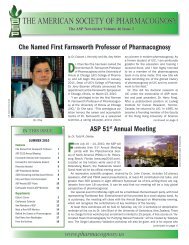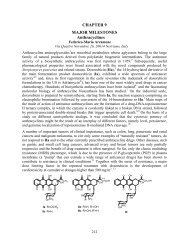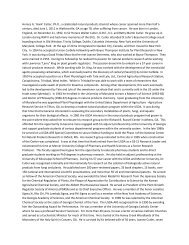Tools for Structure Elucidation
Tools for Structure Elucidation
Tools for Structure Elucidation
- No tags were found...
Create successful ePaper yourself
Turn your PDF publications into a flip-book with our unique Google optimized e-Paper software.
Innovation with Integrity<strong>Tools</strong> <strong>for</strong> <strong>Structure</strong> <strong>Elucidation</strong>Sandra Groscurth
Characterization of Unknown <strong>Structure</strong>scharacterization of extracted compounds that show activity:first of all, is it a new compound, is the structure unknown?⇨ dereplication by MS/MS⇨ molecular <strong>for</strong>mula determination by mass spectrometry
Structural Characterization by MSNumber of hits depending on mass accuracy250 hits @ ±10 ppm137 hits @ ±5 ppm78 hits @ ±3 ppmm/z = 609.28:10 ppm ⇨ 0.006 Da0.05 ppm ⇨ 0.00003 Da0.03 mDa29 hits @ ±1 ppm3 hits@ ±0.1 ppm1 hit@ ± 0.05ppmImpossible <strong>for</strong> anyMS technology ona routine basis• resolution 20000 FWHM• accuracy 1–2 ppm
Accurate Mass Determinationdetection of single ion signal:TDCtrigger level43ADC21922.00 922.01 922.02 [m/z]2 GHz Digitizer = sampling rate 0.5 ns
Time to Digital Convertertime in<strong>for</strong>mation of the histogram peak is converted byinterpolation and calibration into mass in<strong>for</strong>mationmass positionintensity= 922.009 m/z= 4 counts43peak width (FWMH)= 0.06 Da21mass positionresolution = = 15400peak width922.00 922.01 922.02 [m/z]
Time to Digital Converterwith higher sample concentration two or more ionsper acceleration pulse may reach the MCP detectorin this example with the same numberof ions reaching the detector, only60% of these ions were converted43⇨ wrong intensity⇨ wrong mass position21922.00 922.01 922.02 [m/z]
Accurate Mass Determinationto avoid dead time effects: different digitizer technologyTDCtrigger levelcorrect intensitycorrect mass position43ADC21922.00 922.01 922.02 [m/z]
Accurate Mass Determinationcomparing true isotopic pattern of insulinIntens.6000ADC3456C254H383N65O75S6 ,5735.65experimental patterntheoretical patternTDC34experimental patterntheoretical pattern40002000278256701910111146.0 1146.5 1147.0 1147.5 1148.0 1148.5 1149.0 1149.5 1150.0 m/z18910 11⇨ ADC digitizer technology preferred <strong>for</strong> any MS instrument
SmartFormula – MS Data Interpretation⇨ unambiguous elemental composition determination bycombined accurate mass and isotopic pattern in<strong>for</strong>mation
SmartFormula – MS Data InterpretationOverlay of measured and simulated spectrum:⇨ sum <strong>for</strong>mula C 29 H 42 NO 4 shows perfect match <strong>for</strong> the isotopic patterns
Accurate molecular <strong>for</strong>mula from MS/MS# possible <strong>for</strong>mulaenumerousmass accuracyseveral ppm accuracymediumplus chemical expertiseadditional confidencefewplus SmartFormula(mass accuracy + TIP)singleplus SmartFormula3D(fragments-based TIP)⇨ unambiguous <strong>for</strong>mula ID• resolution 40-60000 FWHM• accuracy 1 ppm (MS & MS/MS)⇨ definitive molecular <strong>for</strong>mulae• 20 full spectra/sec
Accurate molecular <strong>for</strong>mula from MS/MSMSMS/MSParentFragments• elemental <strong>for</strong>mulae <strong>for</strong> parent ions by SmartFormula• elemental <strong>for</strong>mulae <strong>for</strong> fragment ions by SmartFormula⇨ every ‘true’ fragment <strong>for</strong>mula must be a sub-set of the ‘true’ parent <strong>for</strong>mula⇨ SmartFormula3D
Accurate molecular <strong>for</strong>mula from MS/MSMSMS/MSParentFragmentsproposed molecular <strong>for</strong>mulaeof precursor ion aftercombination of MS andMS/MS in<strong>for</strong>mationmolecular <strong>for</strong>mulae offragment ions
Accurate molecular <strong>for</strong>mula from MS/MScharacterization of unknown compound by MS/MS:molecular <strong>for</strong>mula based on TIP of MS and MS/MS spectra⇨ C 29 H 41 NO 4⇨ structure elucidation by NMR
NMR Spectra <strong>for</strong> <strong>Structure</strong> <strong>Elucidation</strong>• 1D NMR spectrao 1D Protono 1D Carbonchemical shifts ⇨ functional groupsaliphaticaldehydeprotonCH 3• 2D NMR spectraHo HSQC ⇨ 1J CHcarbonylcarbonHHHaromatico COSY ⇨ 3J HHo HMBC ⇨ 2J CH / 3 J CHo TOCSY ⇨ spin systemcorrelations ⇨ neighboring atomso ROESY ⇨ through space
NMR Hardware Developmentsexperimentrel. sensitivity1H 1.0013C 0.01HSQC 0.25COSY 0.20HMBC 0.07TOCSY 0.12• NMR spectra <strong>for</strong> structureelucidation are less sensitive• sample amounts are typicallyvery littleROESY 0.07in order to reduce the experimental time⇨ increase NMR sensitivity
Increase NMR Sensitivity• increase sensitivity by increasing the magnetic field strengthDMB 0• increase (mass) sensitivity through probe technologyo small volume probes: increase mass sensitivityo CryoProbes: decrease noise and thus increase signal to noiseo combine both: best signal to noise and highest mass sensitivity
Small Volume NMR Probesbenefit of small volume NMR probes: increase mass sensitivityB 1m = const.1/d• distance 1 H coil to NMR tuberelevant parameters:• diameter of NMR tube⇨ same number of spins increases sensitivity <strong>for</strong> small volume probes
Small Volume NMR Probes• no problems with solvent impurities (high analyte concentration evenwith very small sample amounts)• no problems with solvent suppression (no radiation damping, etc.)• advantage of working with small sample amountso often easier to get clean samples in small amountso no danger to overload HPLC columnso possibility to use analytical HPLC columns and fraction collect(better separation with small sample amounts)
Small Volume NMR ProbesProbehead Diameter [mm] 1 1.7 3 5Sample Volume [µl] 5 30 180 500Recommended Concentration [mM] 30 10 2.2 1Sample Amount [µmol] 0.15 0.30 0.40 0.50Mass Sensitivity ~ 4 ~ 2.8 ~ 1.4 1Experiment Time 1 2 8 16⇨ 0.6 mg of compound is enough to acquire all required 1D and2D NMR spectra on a 1.7mm RT @ 400 MHz over the weekend
Small Volume NMR Probes: 1.7mm RT30 120 110 100 90 80 70 60 50 40 30 20 10 ppmHSQC1D 1 HCOSYTOCSYNOESYHSQCHMBCH2BC1D 13 C120µg of a Steroid ( 350g/mol) in 30µl ( 11mM) < 24 h on 600MHzppm1020304050607080904.5 4.0 3.5 3.0 2.5 2.0 1.5 1.0 0.5 ppm1 scan20 min45 min4 h10 min3.5 h4 h8 h
Cryogenic NMR Probesbenefit of cryogenic NMR probes: decrease noiseN4K 80K 298KTM: magnetizationB 0 : static fieldR c : ‘resistance in coil’R s : ‘resistance in sample’T c : coil temperatureT s : sample temperatureTPA: preamplifiers equivalente noise temperaturecooling NMR coil reduces electronic noise⇨ increases signal/noise
Cryogenic NMR Probes: huge selectionHe cooledN 2 cooled
Highest Versatility: BBO CryoProbe• 13 C sensitivity 4 ∗ BBO RT• 15 N sensitivity 4 ∗ BBO RT• 1 H sensitivity 3 ∗ BBO RT• observe and inverse detection• cold preamplifiers <strong>for</strong> BB/ 1 H/ 2 H• z-gradient• ATM compatible• 0゜ – 80゜C (standard sample temperaturerange)• available <strong>for</strong> 400 – 700 MHz
Maximum Carbon Sensitivity: DCH1D 1 HHSQC1D 13 C1 min10 min30 minppm406080100120140HSQC9 8 7 6 5 4 3 2 ppm0.5mg of Quinine ( 225mol/l) in 600µl ( 2.4mM) on 700MHz
Maximum Mass Sensitivity: 1.7 CryoProbe1D 1 HHSQCHMBC1D 13 C1 scan5 min10 min40 minHMBC120µg of a Steroid ( 350g/mol) in 30µl ( 11mM) < 2 h on 600MHz
CryoProbe ProdigyCryoProbe Prodigy: alternative at medium fieldProdigy• liquid nitrogen <strong>for</strong> cryo-cooling• small footprint• Prodigy BBOBBO• Prodigy TCI⇨13C sensitivity 2-3 ∗ BBO160 150 140 130 120 110 100 90 80 70 60 50 40 30 20 10 ppm50mM Quinine, 32 scans
CryoProbe Prodigy: 13 C sensitivityINADEQUATEppm140ppm0145150155160165170204017518060185190160 155 150 145 140 135 130 125 120 115 110 105 100 ppm80100120140160180150 140 130 120 110 100 90 80 70 60 50 40 30 20 ppm17.5mg of Quinine ( 225g/mol) in 600µl ( 100mM): expt. time 16 h
Summary NMR Probessmall volume probes⇨ increasing mass sensitivity• 1.7mm RT• 1mm RTcryogenic probes⇨ decrease noise and increase signal/noiseN 2 cooled• Prodigy⇨ sensitivity boost at af<strong>for</strong>dable priceHe cooled• BBO• DCH• 1.7mm⇨ highest versatility⇨ highest carbon sensitivity⇨ highest mass sensitivity
NMR – Workflow <strong>for</strong> <strong>Structure</strong> <strong>Elucidation</strong>1D Proton, 1D Carbonfunctional groups2D HSQC1J CH correlation (CH, CH 2 , CH 3 )CH 3CH 3HCH2D COSYH 3 CCH 23J HH correlationHHH2D HMBC, 2D TOCSY2J CH / 3 J CH correlation, spin system2D ROESY, 2D NOESYthrough space correlation
NMR Spectroscopy – 1D ProtonH 2 ODMSOroof top effect:AB spin systemmethylmethyltert-butyl–NH–OHaromatic protons1 11 11113 2 111 22224 10 2 2 1NMR spectra by courtesy of Wim Vermeulen, Johnson & Johnson
NMR Spectroscopy – 1D CarbonAPT (Attached Proton Test) spectrum <strong>for</strong> assigning multiplicities in 13 C spectra⇨ positive signals: CH 2 -groups & quaternary C⇨ negative signals: CH-groups & CH 3 -groupssp 2 -hybridizedHHsp 3 -hybridizedR 1R 4NMR spectra by courtesy of Wim Vermeulen, Johnson & JohnsonR 2R 3chemical shifts < 145ppm⇨ no carbonyl carbon⇨ functional groups <strong>for</strong> O-atoms: alcohol & ether
NMR Spectroscopy – 2D HSQCHSQC spectrum ⇨ 1J CH correlation(identifying protons & carbons that are bound to each other)HHR 1R 4R 2R 3CH 3CH 2CH 2⇨5x CH 3OHCH9x CH 24x CH sp 32x CH sp 25x C sp 34x C sp 22x OH/NHCHNMR spectra by courtesy of Wim Vermeulen, Johnson & Johnson
NMR Spectroscopy – 2D COSYCOSY spectrum ⇨ 3J HH correlation(identifying CH x -fragments that are covalently bound)HHR 1R 4R 2R 3CH 2 - CH 2CH - CH 2geminal correlations⇨ no additionalin<strong>for</strong>mationCH - CH 2vicinal correlations⇨ covalently boundCH x -fragmentsNMR spectra by courtesy of Wim Vermeulen, Johnson & Johnson
NMR Spectroscopy – 2D HMBCHMBC spectrum ⇨ 2J CH / 3 J CH correlation(connecting CH x - fragments with neighbored carbons)HHR 1R 4R 2R 3CH with 7 C’s in 2/3 bond distance⇨in<strong>for</strong>mationaboutquaternarycarbonsNMR spectra by courtesy of Wim Vermeulen, Johnson & Johnson
Putting together the fragments1D Proton, 1D Carbonfunctional groups2D HSQC1J CH correlation (distinguish CH, CH 2 , CH 3 )application of the rule of doublebondequivalents (DBE):• 10 DBE <strong>for</strong> C 29 H 41 NO 4• 3 DBEs C=C2D COSY3J HH correlation⇨ 7 ring closure left <strong>for</strong> C 29 H 41 NO 42D HMBC, 2D TOCSY2J CH / 3 J CH correlation, spin system
NMR Spectroscopy – 2D <strong>Structure</strong>… after quite some detective work …
NMR Spectroscopy – 2D NOESYROESY / NOESY spectrum ⇨ through space correlation(stereochemistry and 3D structure)NMR spectra by courtesy of Wim Vermeulen, Johnson & Johnson
NMR Spectroscopy – 3D <strong>Structure</strong>3D structure of Buprenorphine⇨ small volume NMR probes allow acquisition of all 1D & 2D spectra required<strong>for</strong> structure elucidation on only 0.6 mg of compound within one weekend
Computer Assisted <strong>Structure</strong> <strong>Elucidation</strong>structure elucidation is a time-consuming and challenging task<strong>Structure</strong><strong>Elucidation</strong>a lot of analytical data have to be analyzed in order to find the right structure⇨ computer assisted data interpretation<strong>for</strong> small organic molecule NMR:CMC-se
Manual <strong>Structure</strong> <strong>Elucidation</strong>Acquired DataGenerate <strong>Structure</strong>HHExtract In<strong>for</strong>mationIdentify Fragments# 13C chem. shift 1H chem. shift Equivalent Hybridization Func. group HMBC COSY21 26.69 1.04 3 sp 3 tert-butyl 16, 912 52.31 3.49 sp 3 methoxy 85 120.01 6.59 sp 2 aromatic 2, 3, 226 118.15 6.74 sp 2 aromatic 1, 2, 418 31.73 2.23 sp 2 3, 7, 14 1318’ 31.73 1.90 sp 2 3, 7, 14 1315 40.78 2.22 sp 3 7, 8, 9, 23, 24 19
CMC-se – Assisted <strong>Structure</strong> <strong>Elucidation</strong>Acquired Data<strong>Structure</strong> EvaluationPopulates Table<strong>Structure</strong> GenerationTableRefinement
CMC-se – Assisted <strong>Structure</strong> <strong>Elucidation</strong>The Correlation Table• automatically populated• all atoms from the moleculeincluded as rows or columns• filled in cells indicated thepresence of correlations• fully editable by the user• convenient way <strong>for</strong> organizingthe data <strong>for</strong> structure elucidation
CMC-se – Assisted <strong>Structure</strong> <strong>Elucidation</strong>The Combined Spectra Display• all data from the projectincluded in a single screen• all automatically pickedpeaks are displayed• manual corrections to theautomatic data analysis arepossible through this window• correlated cursor between allwindows <strong>for</strong> data evaluation
CMC-se – Assisted <strong>Structure</strong> <strong>Elucidation</strong>• clicking on a peak in the data resultsin that cell being highlighted in thetable and vice versa• modifications in the spectradisplay and correlation tableare synchronized
CMC-se – Assisted <strong>Structure</strong> <strong>Elucidation</strong>NMR in<strong>for</strong>mation MS in<strong>for</strong>mation structure proposalscorrelation tablefragments (optional)
CMC-se – Assisted <strong>Structure</strong> <strong>Elucidation</strong>• generated structuresare linked to thecorrelation table• individual or multiplecorrelations can beviewed on allstructure proposals
CMC-se – Assisted <strong>Structure</strong> <strong>Elucidation</strong>
CMC-assist-Summary• CMC-seBehind the Scenes:Interpretation Engine
Automated Data Analysis• S/N estimation• peak picking• artifact removal• solvent signal search• build correlation lists• find commonfrequencies
Interpretation of NMR Constraints1H- 13 C HSQC spectrum• multiplicity editedo negative signals ⇨ CH 2 -groupo positive signals ⇨ CH- or CH 3 -group• quantitativeo integration of peaks ⇨ distinguish CH- from CH 3 -groupso integral check with 1D 1 H spectrum• 13 C chemical shifto chemical shift < 60 ppm sp 3 hybridizedo chemical shift > 100 ppm sp 2 hybridized
Interpretation of NMR ConstraintsHSQC1D Proton1D Carbonproton distributioncarbon hybridization• 5∗ CH 3 ⇨ sp 3 hybridizedmolecular <strong>for</strong>mulaC 29 H 41 NO 4• 9∗ CH 2 ⇨ 9∗ sp 3 / 0∗ sp 2 hybridized• 6∗ CH ⇨ 4∗ sp 3 / 2∗ sp 2 hybridized• 9∗ C ⇨ 5∗ sp 3 / 4∗ sp 2 hybridized
Interpretation of NMR ConstraintsHMBC and COSY cross peaks <strong>for</strong> connection of heavy atomsHMBC (required)2J – 3 JHHCOSY (optional)3J• CH 3 ⇨ one neighboring carbon atom ⇨ 0-1 COSY, 0-2 HMBC correlationsH• CH 2 ⇨ two neighboring carbon atoms ⇨ 0-2 COSY, 0-4 HMBC correlations• …• sp 2 hybridized carbon has to have a sp/sp 2 hybridized neighbor
Interpretation of NMR Constraints• second first bond bond creation:H 3 C – CH⇨ 2 – COSY: ⇨ COSY: H 3 C – HCH 3 C 2 – CH 2 – CH =⇨ 2J HMBC: ⇨ 2 J HMBC: H 3 C – HCH 3 C 2 – CH 2 – CH –⇨ 3J HMBC: ⇨ 3J HMBC: H 3 C – HX 3 – C CH – CH 2 – 2 – X – CH –H 3 C – CH 2 – ⇨ COSY: H 3 C – CH 2 – CH =⇨ 2J HMBC: H 3 C – CH 2 – CH –⇨ 3J HMBC: H 3 C – CH 2 – X – CH –too few correlations:only fragments build uptoo many correlations:even more possibilitiesH 3 C – X – CH 2 – ⇨ COSY: H 3 C – X – CH 2 – CH =⇨ 2J HMBC: H 3 C – X – CH 2 – CH –⇨ 3J HMBC: H 3 C – X – CH 2 – X – CH –
Interpretation of NMR ConstraintsHSQC1D Proton1D Carbonproton distributioncarbon hybridizationHMBCCOSYatom connection• HMBC correlations are essential to assemble amolecular structure from individual atoms• number of structure proposals depends on thenumber of (ambiguous/unambiguous) correlations
Adjustments <strong>for</strong> <strong>Structure</strong> Generation• long range correlations have tobe taken into accounto increasing number ofcorrelations that are autoeliminatedby the softwarestep by step• in<strong>for</strong>mation about rings length• in<strong>for</strong>mation about substructures(MS fragments)
Evaluating <strong>Structure</strong> Proposals
CMC-se – Assisted <strong>Structure</strong> <strong>Elucidation</strong>as structure elucidation is a time-consuming and challenging task …<strong>Structure</strong><strong>Elucidation</strong>• CMC-se significantly speeds up the process of data analysis• CMC-se organizes the workflow• CMC-se generates structure proposals that all fit the experimental data
<strong>Structure</strong> <strong>Elucidation</strong> of Natural Productscharacterization of unknown compound by NMR:structure elucidation based on 1D and 2D NMR spectra⇨⇨ synthesizing natural product
Synthesis of Buprenorphine⇨ verifying synthesis steps by NMR
CMC-se – Assisted <strong>Structure</strong> VerificationAcquired Data<strong>Structure</strong> VerificationPopulates Table<strong>Structure</strong> ProposalsTableRefinement
CMC-se – Assisted <strong>Structure</strong> VerificationPopulate Verify structure correlation proposals table• define provide project .mol or .sdf file• provide per<strong>for</strong>m molecular automated <strong>for</strong>mula verification• include automated all spectra elimination <strong>for</strong> of longverification range correlations purpose• per<strong>for</strong>m automatedspectra analysis• manually inspect andrefine correlation tableVerify structure proposals based on the correlation table
CMC-se – Assisted <strong>Structure</strong> Verification7J very unlikely
CMC-se – Assisted <strong>Structure</strong> Verification4J possible
CMC-se – Assisted <strong>Structure</strong> Verification
CMC-se – Assisted <strong>Structure</strong> Verification<strong>Structure</strong>VerificationSynthesizedCompoundInput:• full set of NMR spectra• molecular structuresOutput:• possible assignment
Summary <strong>Tools</strong> <strong>for</strong> <strong>Structure</strong> <strong>Elucidation</strong>mass spectrometry:• ADC digitizer technology <strong>for</strong> accurate mass determination• software package SmartFormula:o analysis of accurate mass and TIP <strong>for</strong> MS and MS/MSNMR spectroscopy:• small volume probes: increase mass sensitivity• cryoProbes: decrease noise and thus increase signal to noise• software package CMCse:o assisted structure verification and elucidationo automated analysis of 1D and 2D NMR spectra
AcknowledgmentWim VermeulenLukas ObererApplication & Development Team
Acknowledgment… thank you <strong>for</strong> your attention!
Copyright © 2011 Bruker Corporation. All rights reserved. www.bruker.comInnovation with Integrity
















